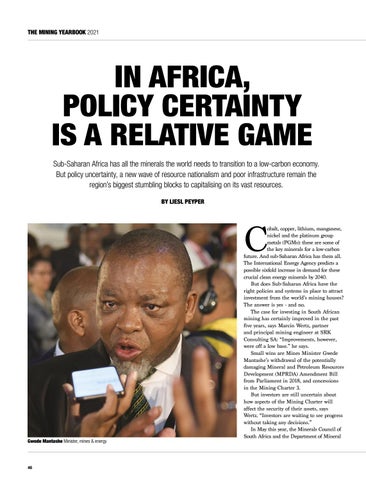THE MINING YEARBOOK 2021
IN AFRICA, POLICY CERTAINTY IS A RELATIVE GAME Sub-Saharan Africa has all the minerals the world needs to transition to a low-carbon economy. But policy uncertainty, a new wave of resource nationalism and poor infrastructure remain the region’s biggest stumbling blocks to capitalising on its vast resources. BY LIESL PEYPER
C
Gwede Mantashe Minister, mines & energy
46
obalt, copper, lithium, manganese, nickel and the platinum group metals (PGMs): these are some of the key minerals for a low-carbon future. And sub-Saharan Africa has them all. The International Energy Agency predicts a possible sixfold increase in demand for these crucial clean energy minerals by 2040. But does Sub-Saharan Africa have the right policies and systems in place to attract investment from the world’s mining houses? The answer is yes - and no. The case for investing in South African mining has certainly improved in the past five years, says Marcin Wertz, partner and principal mining engineer at SRK Consulting SA: “Improvements, however, were off a low base.” he says. Small wins are Mines Minister Gwede Mantashe’s withdrawal of the potentially damaging Mineral and Petroleum Resources Development (MPRDA) Amendment Bill from Parliament in 2018, and concessions in the Mining Charter 3. But investors are still uncertain about how aspects of the Mining Charter will affect the security of their assets, says Wertz. “Investors are waiting to see progress without taking any decisions.” In May this year, the Minerals Council of South Africa and the Department of Mineral













